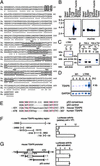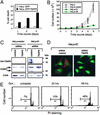The p53-inducible TSAP6 gene product regulates apoptosis and the cell cycle and interacts with Nix and the Myt1 kinase
- PMID: 12606722
- PMCID: PMC151332
- DOI: 10.1073/pnas.0530298100
The p53-inducible TSAP6 gene product regulates apoptosis and the cell cycle and interacts with Nix and the Myt1 kinase
Abstract
The p53 tumor suppressor protein plays a crucial role in tumorigenesis by controlling cell-cycle progression and apoptosis. We have previously described a transcript designated tumor suppressor activated pathway-6 (TSAP6) that is up-regulated in the p53-inducible cell line, LTR6. Cloning of the murine and human full-length TSAP6 cDNA revealed that it encodes a 488-aa protein with five to six transmembrane domains. This gene is the murine and human homologue of the recently published rat pHyde. Antibodies raised against murine and human TSAP6 recognize a 50- to 55-kDa band induced by p53. Analysis of the TSAP6 promoter identified a functional p53-responsive element. Functional studies demonstrated that TSAP6 antisense cDNA diminished levels of the 50- to 55-kDa protein and decreased significantly the levels of p53-induced apoptosis. Furthermore, TSAP6 small interfering RNA inhibited apoptosis in TSAP6-overexpressing cells. Yeast two-hybrid analysis followed by GST/in vitro-transcribed/translated pull-down assays and in vivo coimmunoprecipitations revealed that TSAP6 associated with Nix, a proapoptotic Bcl-2-related protein and the Myt1 kinase, a negative regulator of the G(2)/M transition. Moreover, TSAP6 enhanced the susceptibility of cells to apoptosis and cooperated with Nix to exacerbate this effect. Cell-cycle studies indicated that TSAP6 could augment Myt1 activity. Overall, these data suggest that TSAP6 may act downstream to p53 to interface apoptosis and cell-cycle progression.
Figures





Similar articles
-
A novel eIF5A complex functions as a regulator of p53 and p53-dependent apoptosis.J Biol Chem. 2004 Nov 19;279(47):49251-8. doi: 10.1074/jbc.M407165200. Epub 2004 Sep 14. J Biol Chem. 2004. PMID: 15371445
-
Identification of a consensus motif for Plk (Polo-like kinase) phosphorylation reveals Myt1 as a Plk1 substrate.J Biol Chem. 2003 Jul 11;278(28):25277-80. doi: 10.1074/jbc.C300126200. Epub 2003 May 8. J Biol Chem. 2003. PMID: 12738781
-
Radiation-inducible hSNK gene is transcriptionally regulated by p53 binding homology element in human thyroid cells.Biochem Biophys Res Commun. 2001 Nov 30;289(2):491-8. doi: 10.1006/bbrc.2001.5993. Biochem Biophys Res Commun. 2001. PMID: 11716500
-
Role played by BRCA1 in regulating the cellular response to stress.Biochem Soc Trans. 2003 Feb;31(Pt 1):257-62. Biochem Soc Trans. 2003. PMID: 12546697 Review.
-
Nix Nought Nothing: fairy tale or real deal.J Mol Cell Cardiol. 2011 Oct;51(4):497-500. doi: 10.1016/j.yjmcc.2010.09.011. Epub 2010 Sep 18. J Mol Cell Cardiol. 2011. PMID: 20858501 Free PMC article. Review.
Cited by
-
The PANoptosis-related hippocampal molecular subtypes and key biomarkers in Alzheimer's disease patients.Sci Rep. 2024 Oct 11;14(1):23851. doi: 10.1038/s41598-024-75377-2. Sci Rep. 2024. PMID: 39394418 Free PMC article.
-
Overexpression of PKMYT1 Facilitates Tumor Development and Is Correlated with Poor Prognosis in Clear Cell Renal Cell Carcinoma.Med Sci Monit. 2020 Oct 7;26:e926755. doi: 10.12659/MSM.926755. Med Sci Monit. 2020. PMID: 33024069 Free PMC article.
-
Histone deacetylase inhibitors inhibit cervical cancer growth through Parkin acetylation-mediated mitophagy.Acta Pharm Sin B. 2022 Feb;12(2):838-852. doi: 10.1016/j.apsb.2021.07.003. Epub 2021 Jul 21. Acta Pharm Sin B. 2022. PMID: 35256949 Free PMC article.
-
Phytochemical Modulation of MiRNAs in Colorectal Cancer.Medicines (Basel). 2019 Apr 5;6(2):48. doi: 10.3390/medicines6020048. Medicines (Basel). 2019. PMID: 30959836 Free PMC article. Review.
-
The transcription factor p53: not a repressor, solely an activator.Cell Cycle. 2014;13(19):3037-58. doi: 10.4161/15384101.2014.949083. Cell Cycle. 2014. PMID: 25486564 Free PMC article.
References
-
- Yonish-Rouach E, Resnitzky D, Lotem J, Sachs L, Kimchi A, Oren M. Nature. 1991;352:345–347. - PubMed
-
- Hu G, Chung Y L, Glover T, Valentine V, Look A T, Fearon E R. Genomics. 1997;46:103–111. - PubMed
-
- Sherrington R, Rogaev E I, Liang Y, Rogaeva E A, Levesque G, Ikeda M, Chi H, Lin C, Li G, Holman K, et al. Nature. 1995;375:754–760. - PubMed
MeSH terms
Substances
Associated data
- Actions
- Actions
LinkOut - more resources
Full Text Sources
Other Literature Sources
Molecular Biology Databases
Research Materials
Miscellaneous

